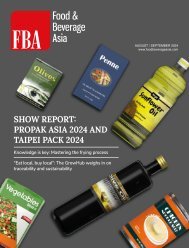Dental Asia March/April 2019
For more than two decades, Dental Asia is the premium journal in linking dental innovators and manufacturers to its rightful audience. We devote ourselves in showcasing the latest dental technology and share evidence-based clinical philosophies to serve as an educational platform to dental professionals. Our combined portfolio of print and digital media also allows us to reach a wider market and secure our position as the leading dental media in the Asia Pacific region while facilitating global interactions among our readers.
For more than two decades, Dental Asia is the premium journal in linking dental innovators
and manufacturers to its rightful audience. We devote ourselves in showcasing the latest dental technology and share evidence-based clinical philosophies to serve as an educational platform to dental professionals. Our combined portfolio of print and digital media also allows us to reach a wider market and secure our position as the leading dental media in the Asia Pacific region while facilitating global interactions among our readers.
You also want an ePaper? Increase the reach of your titles
YUMPU automatically turns print PDFs into web optimized ePapers that Google loves.
Clinical Feature<br />
7 TH GENERATION<br />
ADHESIVE SYSTEMS<br />
By George Freedman DDS, FAACD, FIADFE, Dipl.ABAD<br />
Over the past five decades,<br />
the evolution of adhesive<br />
techniques has transformed<br />
the scope of dental practice.<br />
The vast majority of direct<br />
and indirect restorations are bonded<br />
to natural tooth structure rather than<br />
cemented or mechanically retained.<br />
Extensive research and product<br />
development have improved adhesives,<br />
concurrently with patient demands for<br />
improved oral appearance.<br />
The widespread demand and use of<br />
dental adhesives has fueled an intensive<br />
development of better and easier dental<br />
adhesives in rapid succession; inundating<br />
dentists with successive “generations”<br />
of adhesive materials. While the term<br />
“generation” has no scientific basis in the<br />
realm of dental adhesives and is to a great<br />
extent arbitrary, it has served a useful<br />
purpose in the organisation of the myriad<br />
of commercially available materials into<br />
more comprehensible categories.<br />
The “generational” definitions assist in<br />
identifying the chemistries involved, the<br />
strengths of the dentinal bond, and the<br />
ease of clinical use. Ultimately, this type<br />
of classification benefits both dentist<br />
and patient by simplifying the clinician’s<br />
chairside choices.<br />
The beginning of the generational<br />
adhesive systems<br />
The 1 st generation adhesives in the late<br />
1970s were rather unsuccessful. While<br />
their bond strength to enamel was high,<br />
their dentinal adhesion was pitifully low<br />
at typically less than 2 MPa. Generally, all<br />
the adhesive generations bond well to the<br />
microcrystalline structure of enamel; it is<br />
their bond strength to the semi-organic<br />
dentin that is the greater concern.<br />
“Bonding” was achieved through chelation<br />
of the bonding agent to the calcium<br />
component of the dentin. While tubular<br />
penetration did occur, it contributed little<br />
to the retention of the restoration. It was<br />
common to see debonding at the dentinal<br />
interface within several months. 1 These<br />
bonding agents were recommended for<br />
small, retentive Class III and Class V<br />
cavities. 2 Post-operative sensitivity was<br />
common when these bonding agents were<br />
used for posterior occlusal restorations. 3<br />
In the early 1980s, a distinct 2 nd<br />
generation of adhesives was developed,<br />
attempting to use the smear layer<br />
as a bonding substrate. 4 This layer<br />
bonded to the underlying dentin at a<br />
negligible level of 2-3 MPa. The weak<br />
2-8 MPa dentinal bonding strength of<br />
2 nd generation adhesives meant that<br />
mechanical retention form was still<br />
required. Restorations with margins in<br />
dentin saw extensive microleakage, and<br />
posterior occlusal restorations were<br />
likely to exhibit significant post-operative<br />
sensitivity. The long-term stability of 2 nd<br />
generation adhesives was problematic;<br />
one-year retention rates were as low as<br />
70%. 5,6<br />
In the late 1980s, revolutionary twocomponent<br />
primary/adhesive systems<br />
were introduced. Their marked<br />
clinical improvement warranted their<br />
classification as 3 rd generation adhesives.<br />
Significant increases in dentin bonding<br />
strength (8-15 MPa) diminished the<br />
need for cavity retention form. Erosion,<br />
abrasion, and abfraction lesions were<br />
treatable with minimal tooth preparation,<br />
hence the beginning of ultraconservative<br />
dentistry. A noticeable decrease in<br />
postoperative sensitivity with posterior<br />
occlusal restorations was very welcome.<br />
3 rd generation adhesives were the first<br />
“generation” that bonded not only to<br />
tooth structure, but (weakly) to dental<br />
metals and ceramics as well. The downside<br />
of 3 rd generation bonding agents was<br />
their lack of longevity; intraoral adhesive<br />
retention started to decrease after three<br />
years. Despite significant levels of postoperative<br />
sensitivity, patient demands for<br />
tooth-coloured restorations convinced<br />
some dentists to begin providing posterior<br />
composite fillings routinely. 7,8,9<br />
The transformation and popular<br />
generations of the adhesive systems<br />
In the early 1990s, 4 th generation bonding<br />
agents transformed dentistry. Their high<br />
bond strength to dentin (17-25 MPa)<br />
and limited post-operative sensitivity<br />
in posterior occlusal restorations<br />
encouraged many dentists to switch from<br />
amalgam to direct posterior composite<br />
fillings. 4 th generation is characterised<br />
by the process of hybridisation at the<br />
dentin-composite interface.<br />
Hybridisation is the replacement of the<br />
hydroxyapatite and the water in the<br />
surface dentin by resin. This resin, in<br />
combination with the remaining collagen<br />
fibres, constitutes the hybrid layer.<br />
Hybridisation involves both the dentinal<br />
44<br />
DENTAL ASIA MARCH / APRIL <strong>2019</strong>


















